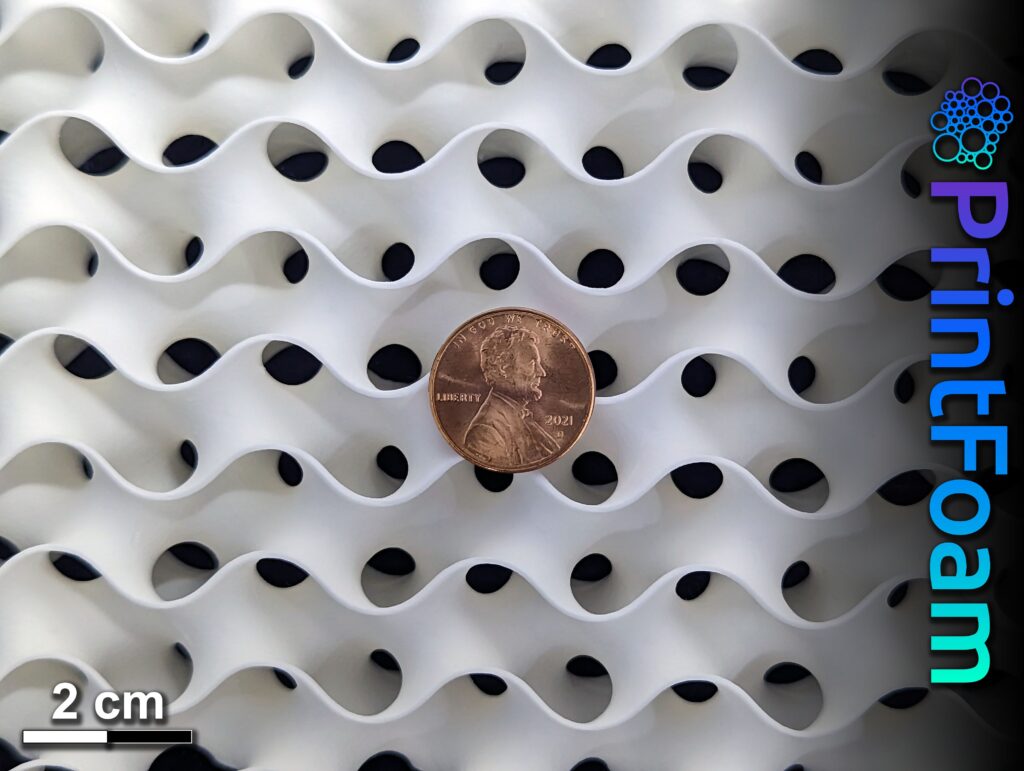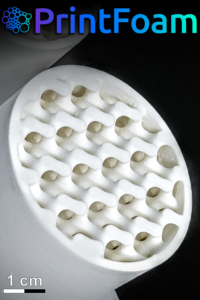One thing you’ll notice if you talk to enough materials scientists is that they’re all passionate. These are people who really care about the things that things are made from.
It’s more important than ever for everyone else to care about materials science, too, if only for the fact that this is where humanity is likely to find a majority of the practical solutions for solving widespread ecological instability. These days, many of the most interesting such solutions are being explored in the realm of composites 3D printing, and perhaps the most interesting of all is 3D printed foam.

CTO of PrintFoam, David Walker
If you didn’t even know there was 3D printed foam, one of the reasons is because PrintFoam has only been trickling out details of its technology after years of development on its signature product, starting at MIT in 2016. 3DPrint.com had the exclusive first interview with Founder and Chief Executive Officer Matthew Pearlson back in 2018 (part one and part two of that interview). While the exact nature of the technology is still a closely guarded secret, it can be described as an advanced, proprietary take on a stereolithography (SLA) process, with all of the proper IP protections in place.
I was given the exciting opportunity to talk to Dr. David Walker — one of those aforementioned passionate materials scientists — the company’s chief technology officer (CTO) and co-founder.
PrintFoam is not just an intriguing advanced materials brand: as Walker made clear, it has a real cohesive corporate identity, one based on aiming big. This is as true about the company’s ambitions for market share as it is about the engineering work underlying the flagship tech.
As Walker summarized at the end of our interview, PrintFoam isn’t interested in serving just any sector: “We’re looking for the whales where we add a lot of value. These aren’t necessarily giant industries today, but we are hunting down applications where we see giant growth potential and the opportunity to be printing big volumes. So, as a result, we work with companies that vary in size: the largest company we’re working with is valued in the tens of billions, …but we’re [also] working with brand new companies that are just coming out of universities — because we see their vision, we see how we add value, and we see how we win together in a new emerging sector. …I care about working on projects that have big global scale and meaningful impact. I think that’s the future win for 3D printing in general.”
What is Foam?
Now, if you’re wondering what, precisely, constitutes a foam, you’re in luck — I’m not too proud to admit I had trouble remembering as well, so I asked Walker to clarify the technical definition for me at the beginning of the interview. By the way, our ignorance re: foam is not entirely our fault: there are many products out there in the 3D printing industry that claim to be foam, or foam-like, but aren’t quite the real deal. Additive manufacturing (AM) of foam that is real foam as soon as it’s printed is an achievement unique to PrintFoam, which begins to explain what’s so huge about the company’s technology.
As Walker explained it, “Foam is a multi-phase material — a matrix material, in our case, polymer, with some sort of gaseous phase inside. And there are different types of foam, too. There’s open cell foams, which are like sponges with connected pores throughout the plastic. And then there’s closed cell foams, which have little bubbles trapped inside of the plastic. …[T]ypically the idea of ‘foam’ in 3D printing has centered around this idea of creating a digital lattice structure that tries to mimic the behavior of foam. …when you zoom in on our material, unlike everyone else, we actually have these really nice uniform micro bubbles. This is more typical of what you would find in, say, a shoe sole. You’re going to have these bubbles trapped inside the polymer. It’s not just going to be solid plastic throughout. …Our technology foams the resin at the time of the printing process, not after the fact. And not only that, but we can also control the bubble’s size. It could be whatever size we choose to print in that layer. You can start to imagine a lot of really interesting and cool applications we can now start to explore that you otherwise wouldn’t be able to achieve with foams produced by traditional injection molding.”

Why 3D Print Foam?
So, there you have it — a straightforward, fundamental difference between what PrintFoam has done, and anything else on the market. Still, different is one thing, “better” is another.
“I’m an engineer, so I’m going to tell you that ‘better’ is always relative,” said Walker. “What is foam better for in material science? Usually, its strength-to-weight ratio is very, very good. So, if you’re ever doing light-weighting and things like that — things that we talk about a lot in 3D printing — foams are very uniquely positioned to do that. Additionally, it has some very interesting mechanical, thermal, and acoustical properties. …One of the most important things about using a foamed resin is that it helps drop the usage of materials and, resultantly, the cost for a printed part. One of the biggest limiters to [AM] right now is the cost of materials. When you go to buy resin, the cost of the resin can actually make it too expensive for a lot of, otherwise, killer applications… Well, when you get rid of over half of the weight by trapping air bubbles in there, you’re cutting that expensive resin cost in half. So, not only are you de-weighting the part, but you’re also dropping the cost that it takes to make the part. And that’s a really big bottleneck for the field as a whole.”

Speaking of bottlenecks, another issue in that vein in the AM sector is the time it takes to finish a printed product. Perhaps most often, the lag is related to slow throughput, and printers with higher throughput capacity can only do so much to solve that problem.
“[With foam,] you can actually run your printer faster,” Walker explained. “You have this air bubble coated in a very thin candy shell of goo that you must cure with light. But if you had to cure all of that polymer, a hundred percent liquid resin and no gas, it takes a lot more light energy to get the job done. And so, when we would look at the upper limits of how fast you can run a UV-based 3D printer, one of the fundamental limits becomes how much light energy you can pump into the polymer. How quickly can I pump that energy in to get it to solidify? When you have a foam, you have a lot less material to solidify, so you can run your printer faster.”

Walker with PrintFoam’s co-founder and CEO, Matthew Pearlson
It’s hard to think of more compelling selling points for a class of materials, especially in the AM sector, than the abilities to 1) use markedly less product, and 2) to turn that product into finished goods much faster. The third big selling point for PrintFoam is that, in order to realize its efforts to revolutionize the materials space, the company developed some potentially transformative hardware, as well, for the entire composite 3D printing market. This includes three different printers: the Foam100 for sample scale printing with a 100mm x 100mm x 15mm build volume; the Foam300, for prototype scale with a 300mm x 300mm x 15mm build volume; and the Foam1200, for production scale with a 1200 mm x 2400 mm x 25mm build volume. All printers can fill the entire build volume in approximately 15 minutes and can achieve 20 microns in terms of optical patterning resolution. The minimum feature size is described as 100-200 microns, depending on material and foam properties.
“When you’re printing foamed resins, they’re inherently high viscosity liquids: it doesn’t flow freely like most existing resins out there,” Walker said. “What you really need for that to work is an ability to print highly viscous materials. We have hardware that does just that, which we had to invent to be able to print foamed resins. But, importantly, this technology isn’t just limited to printing foams – it can print many other types of materials, too. It can print ceramic composites and other, really cool, material classes that we haven’t been able to really explore before in great depth.”
Finally, back to those whales. As you’ll hear over and over again if you ever go to a 3D printing trade show, you have to have a business case. Without that, everything else Walker touted would just be a whole bunch of interesting science. If anything, the business case possibilities are what make me most optimistic about PrintFoam’s future, and why I think the advanced manufacturing market is going to become very aware of 3D printed foam, very quickly.
“We’re really interested in the energy sector, process intensification through AM, and reducing material usage. Some of the very first foams that we’ve developed are largely sourced from biomaterials. Meaning, instead of pumping oil out of the ground, we make plastic from biorenewable components — corn, citrus, wood…there are many things like this which we can make plastics from. We’ve made resins and foams that are made from bio-sourced components at very high fractions. While we’re still studying their properties, these eco-friendly foams seem to have very interesting biodegradability aspects, as well. And that’s something really new in the photopolymer world, where typically once you print it, that’s it. You’re done and you must throw the plastic away.”
 I mention it in every post where it’s even remotely relevant, but, along with electronics, I think renewable energy is the future of AM. And, judging from all the money pouring into R&D in the AM sector from the Department of Energy, PrintFoam hit the nail on the head in its search for where the high-value customers are most likely to be found. This might be the first time you’re hearing of PrintFoam, but it’s not going to be the last.
I mention it in every post where it’s even remotely relevant, but, along with electronics, I think renewable energy is the future of AM. And, judging from all the money pouring into R&D in the AM sector from the Department of Energy, PrintFoam hit the nail on the head in its search for where the high-value customers are most likely to be found. This might be the first time you’re hearing of PrintFoam, but it’s not going to be the last.
Thanks to PrintFoam, David Walker, and Sarah Goehrke for setting up the interview. Images courtesy of PrintFoam
Subscribe to Our Email Newsletter
Stay up-to-date on all the latest news from the 3D printing industry and receive information and offers from third party vendors.
You May Also Like
3D Printing Financials: Fathom Struggles in Financial Quicksand During Critical Transition
Facing a year of key transitions and financial pressures, Fathom (Nasdaq: FTHM) has filed its annual report for 2023 with the U.S. Securities and Exchange Commission (SEC). The document outlines...
Latest Earnings Overview for Australian 3D Printing Firms Titomic and AML3D
Australian 3D printing manufacturing firms Titomic (ASX: TTT) and AML3D (ASX: AL3) reported their financial results for the period from July to December 2023, marking the first half of their...
3D Printing Webinar and Event Roundup: April 7, 2024
Webinars and events in the 3D printing industry are picking back up this week! Sea-Air-Space is coming to Maryland, and SAE International is sponsoring a 3D Systems webinar about 3D...
3D Printing Financials: Unpacking Farsoon and BLT’s 2023 Performance
In the Chinese 3D printing industry, two companies, Farsoon (SHA: 688433) and Bright Laser Technologies, or BLT (SHA: 688333), have recently unveiled their full-year earnings for 2023. Farsoon reported increases...































